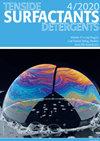短小精悍:平衡节能和清洁性能,确定家用洗碗机的高效短周期
IF 1.2
4区 工程技术
Q4 CHEMISTRY, APPLIED
引用次数: 0
摘要
优化家用电器的能效对电器制造商、能源供应商、政府以及消费者都至关重要。为了可靠地清洗一般脏污的餐具,消费者可以通过使用环保程序而不是密集程序或自动程序来节约能源,但这意味着他们必须接受长达 4 小时的清洗时间。运行时间少于 55 分钟、平均能耗等于或低于环保程序的短周期程序具有很高的消费潜力。不过,根据制造商的说法,这些产品更多是为轻度脏污或预先处理过的餐具而设计的。考虑到 "罪人圈",清洁效果取决于温度、时间、机械和化学的相互作用,因此我们研究了使用市售洗涤剂,从而充分利用 "罪人圈 "中的 "化学 "成分,最终在多大程度上可以节省时间、温度、水,以及最重要的能源。我们的研究结果表明,使用市售洗涤剂的短程序组合可以在 55 分钟内可靠地清洗正常脏污的餐具,通常只需 30-40 分钟,能耗明显低于普通生态循环。本文章由计算机程序翻译,如有差异,请以英文原文为准。
Short and sweet: balancing energy savings and cleaning performance to identify efficient short-cycles for domestic dishwashers
Optimizing the energy efficiency of household appliances is crucial to appliance manufacturers, energy suppliers, governments and, almost importantly, consumers. For the reliable cleaning of normally soiled dishes, consumers can save energy by using Eco-programs instead of Intensive- or Auto-programs, but this means that they have to accept cleaning times of up to 4 h. Consequently, the acceptance for these programs is not very high, despite consumers’ high willingness to save energy and water. Short-cycles that run for less than 55 min and use equal to less energy on average than Eco-programs have a high consumer potential. However, according to manufacturers, these are rather designed for lightly soiled or pre-treated dishes. Considering the Sinner’s circle, the cleaning result depends on the interaction of temperature, time, mechanics and chemistry, so we investigated the extent to which using a commercially available detergent, thus fully exploiting the “chemistry” component of the Sinner’s circle, can save time, temperature, water and, most importantly, energy in the end. Our results show that there are Short-program combinations using a commercially available detergent that reliably clean normally soiled dishes in less than 55 min and typically 30–40 min with significantly lower energy consumption than average Eco-cycles.
求助全文
通过发布文献求助,成功后即可免费获取论文全文。
去求助
来源期刊

Tenside Surfactants Detergents
工程技术-工程:化工
CiteScore
1.90
自引率
10.00%
发文量
57
审稿时长
3.8 months
期刊介绍:
Tenside Surfactants Detergents offers the most recent results of research and development in all fields of surfactant chemistry, such as: synthesis, analysis, physicochemical properties, new types of surfactants, progress in production processes, application-related problems and environmental behavior. Since 1964 Tenside Surfactants Detergents offers strictly peer-reviewed, high-quality articles by renowned specialists around the world.
 求助内容:
求助内容: 应助结果提醒方式:
应助结果提醒方式:


